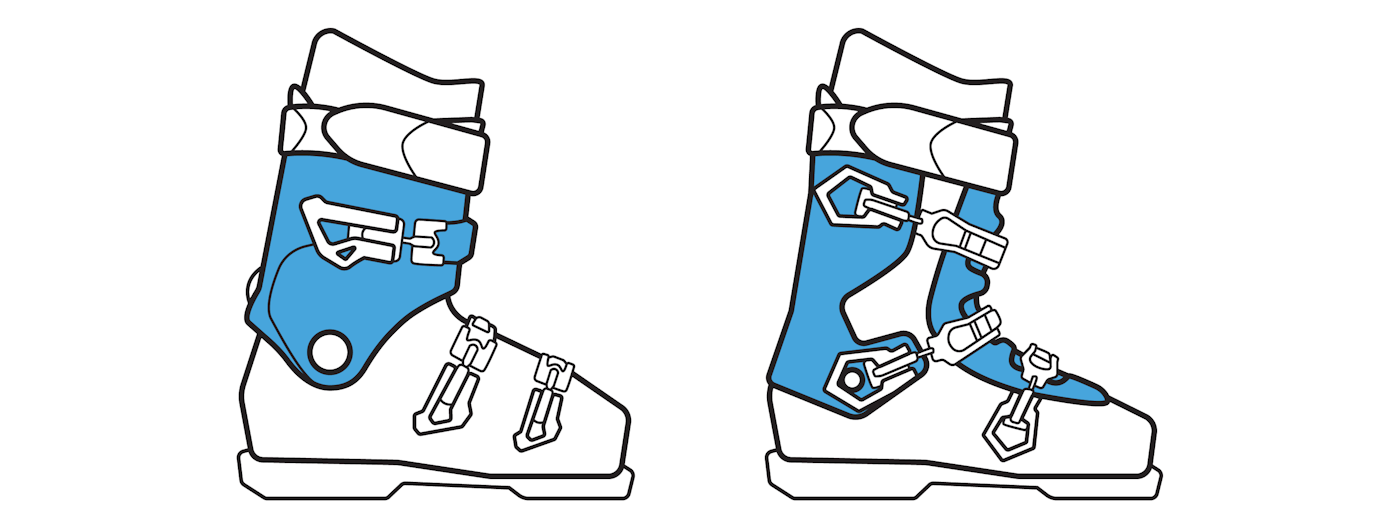Too often taking second place to a shiny new pair of skis, boots are the most critical part of your setup as they are critical to your comfort and control on the mountain. Understanding the different types of boots and features they offer will help you choose the right pair. There’s really no better way to figure out if a boot is a good fit for you than visiting a ski shop and working with an experienced bootfitter. Every foot is unique, so finding a boot that works for you is worth the time and energy. However, a basic understanding of the terms and features will allow you to do your research and understand the different options on the market.
Two-piece (overlap) vs. Three-piece (cabrio) Construction
Overlap boots have a traditional, two-piece shell construction. The lower piece wraps around your foot while the upper piece wraps the leg. They offer precise control, with power being derived from the rear spine of the boot.
Cabrio boots feature a three-piece shell design. The lower piece wraps around your foot while the upper piece wraps the sides and back of your lower leg. The third piece—a plastic tongue— is where the power comes from in this design. The rivets, which connect to the upper and lower parts of the boot, are placed lower on the shell when compared to the overlap design, providing a more progressive flex.


Two-piece Construction (left) vs. Three-piece Construction (right)
Sizing — MondoPoint and Boot Sole Length
Getting the correct fit is critically important. Some people mistakenly think that sizing up (wearing larger boots) will give them more space and thereby create comfort. The truth is that having boots that are too big will cause you just as much pain as ones that are too small, since you’ll end up curling your toes and straining your feet in an effort to control your skis.
Ski boots are sized using the MondoPoint system, which measures the length of your foot in centimeters. For instance, if your foot measures 26.5 centimeters, then you would be fit into a size 26.5 boot. This sizing system was developed in the 1970s as a universal sizing system but you may notice that actual sizing will vary between manufacturers.
The length of the shell, also known as the boot sole length (BSL) is another size indication that’s stamped on the heel of every ski boot. It shows you the actual length of the shell in millimeters. (e.g. 302mm)
Flex
Numerical flex ratings, which range from about 80 to 130, indicate the stiffness of a boot and how much force it will take to engage your ski. Higher-flex boots provide more control at high speed and are suited for advanced and expert skiers, while lower flex ratings offer more comfort, and are ideal for beginners or skiers who simply prefer a softer feel.
Last and Volume
The last of a boot refers to the width of the shell around the forefoot. A narrow last offers a snug fit for narrow foot shapes, while a wider last provides more comfort for broader feet. It should be noted that just because two boots have an identical last measurement does not mean they will fit exactly the same around your foot. The three-dimensional shape of the shell will vary between manufacturers and determine the overall volume of the boot. The best way to find which boots will fit best is to work with a local bootfitter who is familiar with boot volumes across different brands and models.


Instep
The instep is the top part of your foot, just in front of your shin. If you have a high instep, you’ll require boots with more volume to avoid painful pressure points and if you have a low instep, you’ll need a lower volume boot for a snug fit and ample control. Generally, higher insteps are available in two-peice shells and lower insteps in three-piece shells.


Liners
Boot liners provide insulation from the cold and cushioning for your feet. They come in a variety of options, including standard, moldable, or custom-fit. If your foot is an average size and shape a standard liner might work well for you. Most high-end boots now come with heat-moldable (a.k.a. thermoformable) liners which can be heated up and shaped to the contours of your foot for enhanced comfort and control. Fully-custom, aftermarket liners are the priciest option and work well for unusually-shaped feet, or for those who log a ton of days in their boots.
Moldable Shells
Some higher-end boots are offered with moldable shells that can be heated and shaped to your foot, similar to liners. These offer a personalized fit for improved comfort and performance and are especially useful if your feet are slightly different shapes or sizes.
Walk Mode
Some ski boots feature a walk mode, enabling you to tour the backcountry, or maybe just sauntering to your favorite après spot. When first introduced, these mechanisms often lowered the level of downhill performance. In recent years, however, these locking mechanisms have gotten extremely precise, enabling you to retain the power and performance while descending.


![[GIVEAWAY] Win a Legendary Ski Trip with Icelantic's Road to the Rocks](https://www.datocms-assets.com/163516/1765233064-r2r26_freeskier_leaderboard1.jpg?w=200&h=200&fit=crop)
![[GIVEAWAY] Win a Head-to-Toe Ski Setup from IFSA](https://www.datocms-assets.com/163516/1765920344-ifsa.jpg?w=200&h=200&fit=crop)


![[GIVEAWAY] Win a Legendary Ski Trip with Icelantic's Road to the Rocks](https://www.datocms-assets.com/163516/1765233064-r2r26_freeskier_leaderboard1.jpg?auto=format&w=400&h=300&fit=crop&crop=faces,entropy)




![[GIVEAWAY] Win a Head-to-Toe Ski Setup from IFSA](https://www.datocms-assets.com/163516/1765920344-ifsa.jpg?auto=format&w=400&h=300&fit=crop&crop=faces,entropy)

